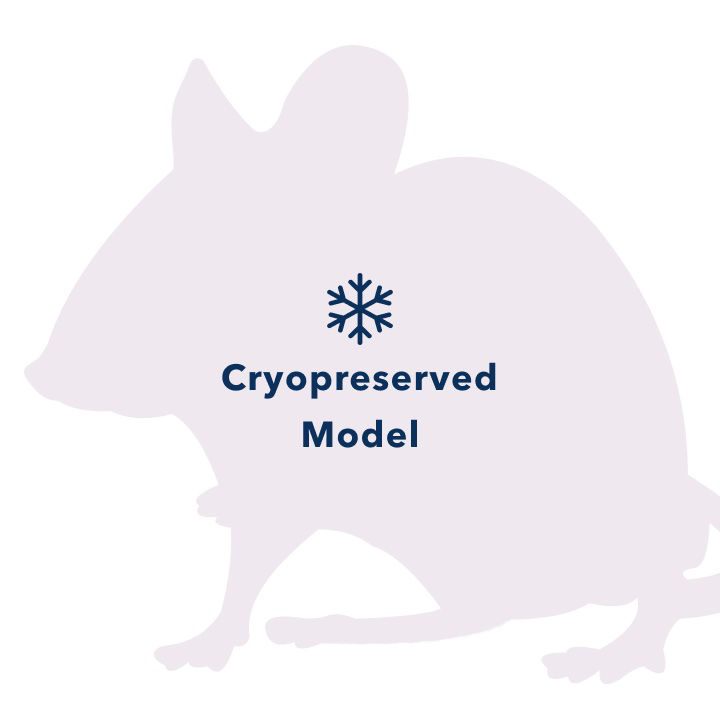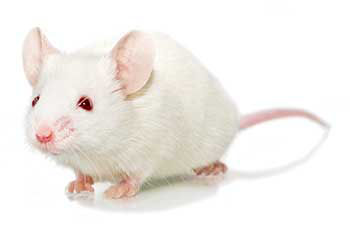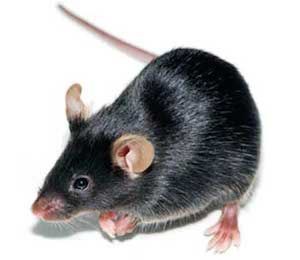Application Areas:
Rag2/OT-II (11490)

| Model No. | Nomenclature | Genotype |
|---|---|---|
| 11490-F | B6.129S6-Rag2tm1Fwa Tg(TcraTcrb)425Cbn | ko/ko;tg/wt |
| 11490-M | B6.129S6-Rag2tm1Fwa Tg(TcraTcrb)425Cbn | ko/ko;tg/wt |
- Description
- Related Products & Services
- Price & Licensing
- Health Report
- Overview
- Genetics
- Guides & Publications
- Applications & Therapeutic Areas
- Transit, Housing & Welfare
- Diet
Overview
Nomenclature: B6.129S6-Rag2tm1Fwa Tg(TcraTcrb)425Cbn
- Carries a transgene that encodes for a T cell receptor (Valpha2 and Vbeta5) specific for a chicken ovalbumin peptide (323-339) presented by the MHC class II molecule H2-Ab1 (I-Ab)
- Deficient in the recombination activating gene 2 (Rag2) and therefore does not develop mature T and B cells expressing endogenous T cell receptors
- Virtually all CD4+ cells express the transgene
- Useful as a source of homogenous donor CD4+ cells for in vivo adoptive transfer studies to investigate T cell development, memory, activation and tolerance
Recommended Controls
The recommended control for this model is C57BL/6NTac.
Origin
Genetics
Guides & Publications
Initial Publication: Shinkai, Y, Rathbun, G, Lam, KP, Oltz, EM, Stewart, V, Mendelsohn, M, Charron, J, Datta, M, Young, F, Stall, AM, and Alt, FW. (1992) RAG-2-Deficient Mice Lack Mature Lymphocytes Owing to Inability to Initiate V(D)J Rearrangement, Cell, 68: 855-867.
Barnden MJ, Allison J, Heath WR, Carbone FR. (1998) Defective TCR expression in transgenic mice constructed using cDNA-based α- and Β-chain genes under the control of heterologous regulatory elements. Immunol Cell Biol 76:34-40.
Applications & Therapeutic Areas
- Autoimmune Disease
- Immunology
- Inflammation
Transit, Housing & Welfare
Need more info? Click the live chat button or Contact Us
Packing Practices
Taconic standard practice is to recombine animals of different home cages and/or ages from a single model and sex during packing, except in specific cases where Taconic's animal welfare policy prohibits recombination due to aggression or other concerns. When an order is fulfilled with animals from more than one week of birth, this standard practice results in animals from a range of birth weeks packed together in a single TTC. When an order is fulfilled with animals from genotyped models, this standard practice results in animals from different home cages packed together in a single TTC.
Customers who wish to keep animals from different weeks of birth separated should place orders with the special instruction "Divide and label by age." Note that this special request can result in increased costs for additional Taconic Transit Cages, dividers and/or freight charges.
Taconic discourages other types of custom packing requests as they can have a negative impact on animal welfare. Learn more.
Diet
- Services
- Licensing
- Pricing - USD
- Pricing - EUR
- Pricing - DKK
- Pricing - USD Nonprofit
- Pricing - EUR Nonprofit
- Pricing - DKK Nonprofit
- Select my Health Standard
- Get Custom Pricing Guide
Rag2/OT-II (11490)
Conditions of Use for Taconic Transgenic Models™
Taconic Transgenic Models™ (Models) are produced and distributed under rights to patents and intellectual property licensed from various institutions. Taconic sells the Models to purchasers, grants to each purchaser a right under Taconic's rights in such licensed patents and intellectual property to use the purchased Model in consideration of purchasers' acknowledgement of and agreement to the Terms and Conditions for Taconic Models, Products and Services and the following terms of use:
- Title to these Models and biological materials derived from them remains with Taconic.
- The Models will be used for research purposes only.
- The Models will not be bred or cross-bred except to obtain embryos or fetuses required for research purposes unless additional rights have been granted in writing by Taconic.
- The Models and biological materials derived from them will not be distributed to third parties or used for commercial purposes.
- Non-profit purchasers may not use this Model and/or biological materials derived from it in sponsored research or contract research studies unless it is purchased at the for-profit price.
Pricing - USD
Murine Pathogen Free (MPF) Health Standard
11490 Female
11490-F Genotype ko/ko;tg/wt
Pilot-sized cohorts are readily available. Large cohort requests have a minimum 8-week lead time. An estimated lead time will be provided to you within 2-3 business days.
| Age in Weeks | Quantity 1 - 999 |
|---|---|
| 3 to 10 | US$340.00 |
11490 Male
11490-M Genotype ko/ko;tg/wt
Pilot-sized cohorts are readily available. Large cohort requests have a minimum 8-week lead time. An estimated lead time will be provided to you within 2-3 business days.
| Age in Weeks | Quantity 1 - 999 |
|---|---|
| 3 to 10 | US$340.00 |
Pricing - EUR
Murine Pathogen Free (MPF) Health Standard
11490 Female
11490-F Genotype ko/ko;tg/wt
Pilot-sized cohorts are readily available. Large cohort requests have a minimum 8-week lead time. An estimated lead time will be provided to you within 2-3 business days.
| Age in Weeks | Quantity 1 - 999 |
|---|---|
| 3 to 10 | 309,00 € |
11490 Male
11490-M Genotype ko/ko;tg/wt
Pilot-sized cohorts are readily available. Large cohort requests have a minimum 8-week lead time. An estimated lead time will be provided to you within 2-3 business days.
| Age in Weeks | Quantity 1 - 999 |
|---|---|
| 3 to 10 | 309,00 € |
Pricing - DKK
Murine Pathogen Free (MPF) Health Standard
11490 Female
11490-F Genotype ko/ko;tg/wt
Pilot-sized cohorts are readily available. Large cohort requests have a minimum 8-week lead time. An estimated lead time will be provided to you within 2-3 business days.
| Age in Weeks | Quantity 1 - 999 |
|---|---|
| 3 to 10 | kr.2.299,00 |
11490 Male
11490-M Genotype ko/ko;tg/wt
Pilot-sized cohorts are readily available. Large cohort requests have a minimum 8-week lead time. An estimated lead time will be provided to you within 2-3 business days.
| Age in Weeks | Quantity 1 - 999 |
|---|---|
| 3 to 10 | kr.2.299,00 |
Pricing - USD Nonprofit
Murine Pathogen Free (MPF) Health Standard
11490 Female
11490-F Genotype ko/ko;tg/wt
Pilot-sized cohorts are readily available. Large cohort requests have a minimum 8-week lead time. An estimated lead time will be provided to you within 2-3 business days.
| Age in Weeks | Quantity 1 - 999 |
|---|---|
| 3 to 10 | US$340.00 |
11490 Male
11490-M Genotype ko/ko;tg/wt
Pilot-sized cohorts are readily available. Large cohort requests have a minimum 8-week lead time. An estimated lead time will be provided to you within 2-3 business days.
| Age in Weeks | Quantity 1 - 999 |
|---|---|
| 3 to 10 | US$340.00 |
Pricing - EUR Nonprofit
Murine Pathogen Free (MPF) Health Standard
11490 Female
11490-F Genotype ko/ko;tg/wt
Pilot-sized cohorts are readily available. Large cohort requests have a minimum 8-week lead time. An estimated lead time will be provided to you within 2-3 business days.
| Age in Weeks | Quantity 1 - 999 |
|---|---|
| 3 to 10 | 309,00 € |
11490 Male
11490-M Genotype ko/ko;tg/wt
Pilot-sized cohorts are readily available. Large cohort requests have a minimum 8-week lead time. An estimated lead time will be provided to you within 2-3 business days.
| Age in Weeks | Quantity 1 - 999 |
|---|---|
| 3 to 10 | 309,00 € |
Pricing - DKK Nonprofit
Murine Pathogen Free (MPF) Health Standard
11490 Female
11490-F Genotype ko/ko;tg/wt
Pilot-sized cohorts are readily available. Large cohort requests have a minimum 8-week lead time. An estimated lead time will be provided to you within 2-3 business days.
| Age in Weeks | Quantity 1 - 999 |
|---|---|
| 3 to 10 | kr.2.299,00 |
11490 Male
11490-M Genotype ko/ko;tg/wt
Pilot-sized cohorts are readily available. Large cohort requests have a minimum 8-week lead time. An estimated lead time will be provided to you within 2-3 business days.
| Age in Weeks | Quantity 1 - 999 |
|---|---|
| 3 to 10 | kr.2.299,00 |
Select my Health Standard
Need help choosing the right Taconic Biosciences health standard for your research?
Use the Health Standard Selector to enter your exclusion list. The tool will tell you which health standards meet your requirements.
Get custom pricing guide
Schedule A Scientific Consultation
Connect directly with a member of our Scientific Solutions team who can help you select the most appropriate model and maximize your experimental success.
















.jpg)

.jpg)
.jpg)
.jpg)
.jpg)





.jpg)


.jpg)
.jpg)




.jpg)




.jpg)

.jpg)








